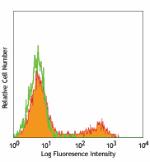- Clone
- G7 (See other available formats)
- Regulatory Status
- RUO
- Other Names
- Thy-1, Thy1
- Isotype
- Rat IgG2c, κ
- Ave. Rating
- Submit a Review
- Product Citations
- publications

-

C57BL/6 splenocytes stained with purified G7, followed by anti-rat IgG FITC -

Fresh, frozen mouse spleen was stained with purified CD90 clone G7 conjugated and detected with a FITC CODEX™ oligonucleotide duplex (red). Samples were counterstained with B220 A647 (green). Data generated at Akoya Biosciences, Inc. using the CODEX™ technology.
| Cat # | Size | Price | Quantity Check Availability | Save | ||
|---|---|---|---|---|---|---|
| 105201 | 50 µg | $54 | ||||
| 105202 | 500 µg | $191 | ||||
CD90 is a 25-35 kD immunoglobulin superfamily member, also known as Thy-1. It is expressed on hematopoietic stem cells and neurons, all thymocytes, and peripheral T cells, but not on B cells. CD90 is a glycosylphosphatidylinositol (GPI)-anchored membrane glycoprotein involved in signal transduction. CD90 is involved in costimulation of lymphocyte proliferation and activation, and hematopoietic stem cell differentiation. CD90 has been shown to interact with CD45. The G7 antibody is able to stimulate T cell proliferation and IL-2 secretion and induce apoptosis of thymocytes and CTL clones.
Product DetailsProduct Details
- Verified Reactivity
- Mouse
- Antibody Type
- Monoclonal
- Host Species
- Rat
- Immunogen
- Mouse T-cell hybridoma C6/G8
- Formulation
- Phosphate-buffered solution, pH 7.2, containing 0.09% sodium azide.
- Preparation
- The antibody was purified by affinity chromatography.
- Concentration
- 0.5 mg/ml
- Storage & Handling
- The antibody solution should be stored undiluted between 2°C and 8°C.
- Application
-
FC - Quality tested
IHC-F - Verified - Recommended Usage
-
Each lot of this antibody is quality control tested by immunofluorescent staining with flow cytometric analysis. For flow cytometric staining, the suggested use of this reagent is ≤ 0.25 µg per 106 cells in 100 µl volume. It is recommended that the reagent be titrated for optimal performance for each application.
- Application Notes
-
Clone G7 binds to Thy-1 epitope region A and also recognizes Thy-1.1/CD90.1 and Thy-1.2/CD90.2 alloantigens. Additional reported applications (for the relevant formats) include: in vitro T-cell activation1,3-4,6, induction of apoptosis2,5, and immunohistochemical staining7,8 of zinc-fixed paraffin-embedded sections and acetone-fixed frozen sections. The LEAF™ purified antibody (Endotoxin <0.1 EU/µg, Azide-Free, 0.2 µm filtered) is recommended for functional assays (Cat. No. 105204).
-
Application References
(PubMed link indicates BioLegend citation) -
- Gunter KC, et al. 1984. J. Exp. Med. 159:716. (Activ)
- Hueber AO, et al. 1994. J. Exp. Med. 179:785. (Apop)
- Tentori L, et al. 1988. J. Immunol. 140:1089. (Activ)
- Sugiyama E, et al. 1990. Cell. Immunol. 130:271. (Activ)
- Ucker DS, et al. 1992. J. Immunol. 149:1583. (Apop)
- Kruisbeek AM, et al. 1991. In Current Protocols in Immunology. pp. 3.12.1. (Activ)
- Nitta H, et al. 1997. Cell Vision 4:73. (IHC)
- Whiteland JL, et al. 1995. J. Histochem. Cytochem. 43:313. (IHC)
- Product Citations
-
- RRID
-
AB_313168 (BioLegend Cat. No. 105201)
AB_313168 (BioLegend Cat. No. 105202)
Antigen Details
- Structure
- Ig superfamily, 25-35 kD
- Distribution
-
Hematopoietic stem cells and neurons, all thymocytes, peripheral T cells
- Function
- Lymphocyte costimulation, proliferation and differentiation of hematopoietic stem cells
- Ligand/Receptor
- CD45
- Cell Type
- Hematopoietic stem and progenitors, Mesenchymal Stem Cells, Neurons, T cells, Thymocytes
- Biology Area
- Immunology, Stem Cells
- Molecular Family
- CD Molecules
- Antigen References
-
1. Barclay A, et al. 1997. The Leukocyte Antigen FactsBook Academic Press.
2. Craig W, et al.1993 J. Exp. Med. 177:1331.
3. Mayani H, et al. 1994 Blood 83:2410. - Gene ID
- 21838 View all products for this Gene ID
- UniProt
- View information about CD90 on UniProt.org
Related FAQs
Other Formats
View All CD90 Reagents Request Custom Conjugation| Description | Clone | Applications |
|---|---|---|
| Purified anti-mouse CD90 | G7 | FC,IHC-F |
Customers Also Purchased



Compare Data Across All Formats
This data display is provided for general comparisons between formats.
Your actual data may vary due to variations in samples, target cells, instruments and their settings, staining conditions, and other factors.
If you need assistance with selecting the best format contact our expert technical support team.

 Login/Register
Login/Register 











Follow Us